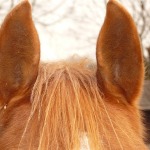Those white growths are most likely Aural Plaques. Aural plaques are benign, raised, crusty, white skin growths on the interior surface of the ear. If you see raised lesions, with a hard, scaly appearance, it’s probably aural plaques. You might also see rounded, knob like protuberances within the scaly area. If your horse is resisting when you touch his ears, that’s another sign. But don’t worry, the plaques are generally painless (though in some horses they cause itchiness and sensitivity). Aural plaques are caused by a papillomavirus infection, most likely spread by the bites of black flies. The bites themselves can cause irritation and inflammation that stimulates the growth of the lesions.
If you suspect your horse has aural plaques, have a veterinarian take a look in order to rule out the possibility of skin tumors that can also show up on the ears (like sarcoids). If your horse is in pain, the protuberances are growing fast, and, or tall, call your veterinarian immediately as those are more likely to be tumors.
For oral plaques, if the horse is suffering from the itchiness, a veterinarian can prescribe a topical cream containing imiquimod (it’s a drug that reduces the size and severity of the plaques). If the horse isn’t in pain or discomfort, there’s no treatment necessary. Just get rid of those pesky black flies!
Share This:








My horse used to get these and they can be very annoying to them. Use a fly fringe and spray in the summer to try and relieve/avoid them. Good article.